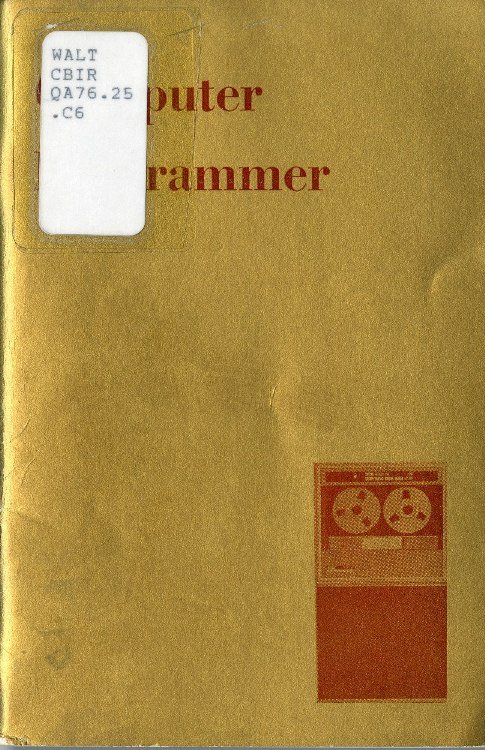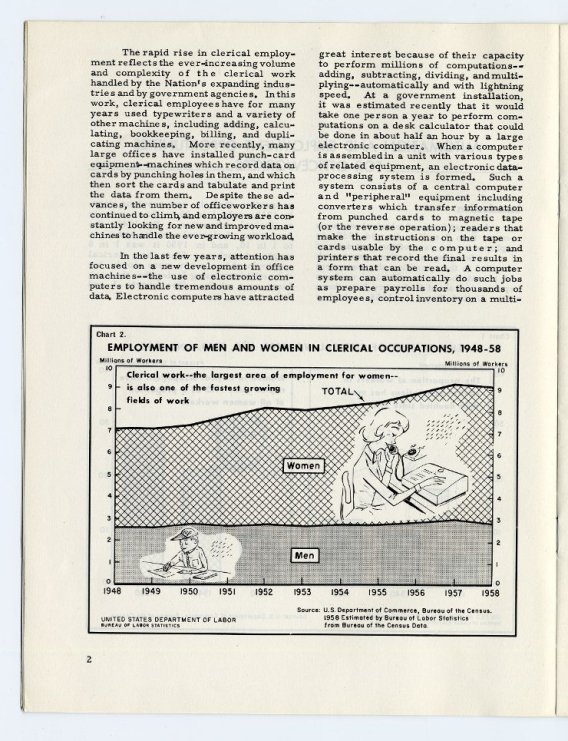Training and Job Opportunities

As computers began to have an impact on traditional office jobs and create new opportunities in technical fields, a variety of messages was conveyed regarding the extent to which these opportunities were open to men and women. Clerical positions, impacted by new tools, still appear to have been marketed more towards women while ads relating to programming and systems analysis addressed an explicitly masculine audience.
Monographs aimed at informing a popular audience about the opportunities in the field of computer programming often had a section or chapter devoted to women’s opportunities. Some made very positive claims about women’s prospects in the field. In Computer Programmer (1965), David W. Cox writes:
"Women will find that there are few barriers to their sex in the programming field. This career, in fact, is perhaps one of the most attractive open to women. A substantial percentage of existing programmers are women." (p. 54)
Others suggested a work environment that the author seemingly thought would appeal to young women. I.J. Seligsohn writes in Your Career in Computer Programming (1967):
"Female programmers are usually outnumbered by males by a ratio of seven-to-one to ten-to-one, and even more in some installations. They go to programming school with men, they train with men, they work with men. Programming is a young profession that attracts bright young men who can advance financially at a faster rate than in many other professions. All told, I’d say that’s a pretty good social environment for the girl programmer and systems engineer." (p. 196-197)
Other reports were not so optimistic. A 1958 report released by the U.S. Department of Labor states:
"Men are preferred as programmer trainees in most areas of work. Although many employers recognize the ability of women to do programming, they are reluctant to pay for their training in view of the large proportion of women who stop working when they marry or when they have children." (United States Department of Labor, Bureau of Labor Statistics in cooperation with Veterans Administration. Automation and Employment Opportunities for Officeworkers: A Report on the Effect of Electronic Computers on Employment of Clerical Workers, with a Special Report on Programmers. Washington, DC: U.S. Government Printing Office, 1958. P. 11. United States National Bureau of Standards Collection of Computer Literature (CBI 32))
Another report released by the Department in 1985 states:
"An important motivation for clerical workers to acquire computer skills has been the belief that such skills would facilitate their entry into high level computer occupations, or into higher paying managerial and executive level jobs. Contrary to the promise of many vendors and schools offering word processing instruction, preliminary research indicates that women clericals are increasingly frustrated by the lack of opportunity for advancement offered them in the “office of the future.” Increasingly, in fact, there is uncertainty among clericals as to whether word processing, per se, should be viewed as a clerical, technical, or professional occupation." Women and Office Automation: Issues for the Decade Ahead. U.S. Department of Labor, William E. Brock, Secretary. Women’s Bureau, Lenora Cole Alexander, Director. 1985. P. 10 James W. Cortada Papers, circa 1890-2007 (CBI 185))



